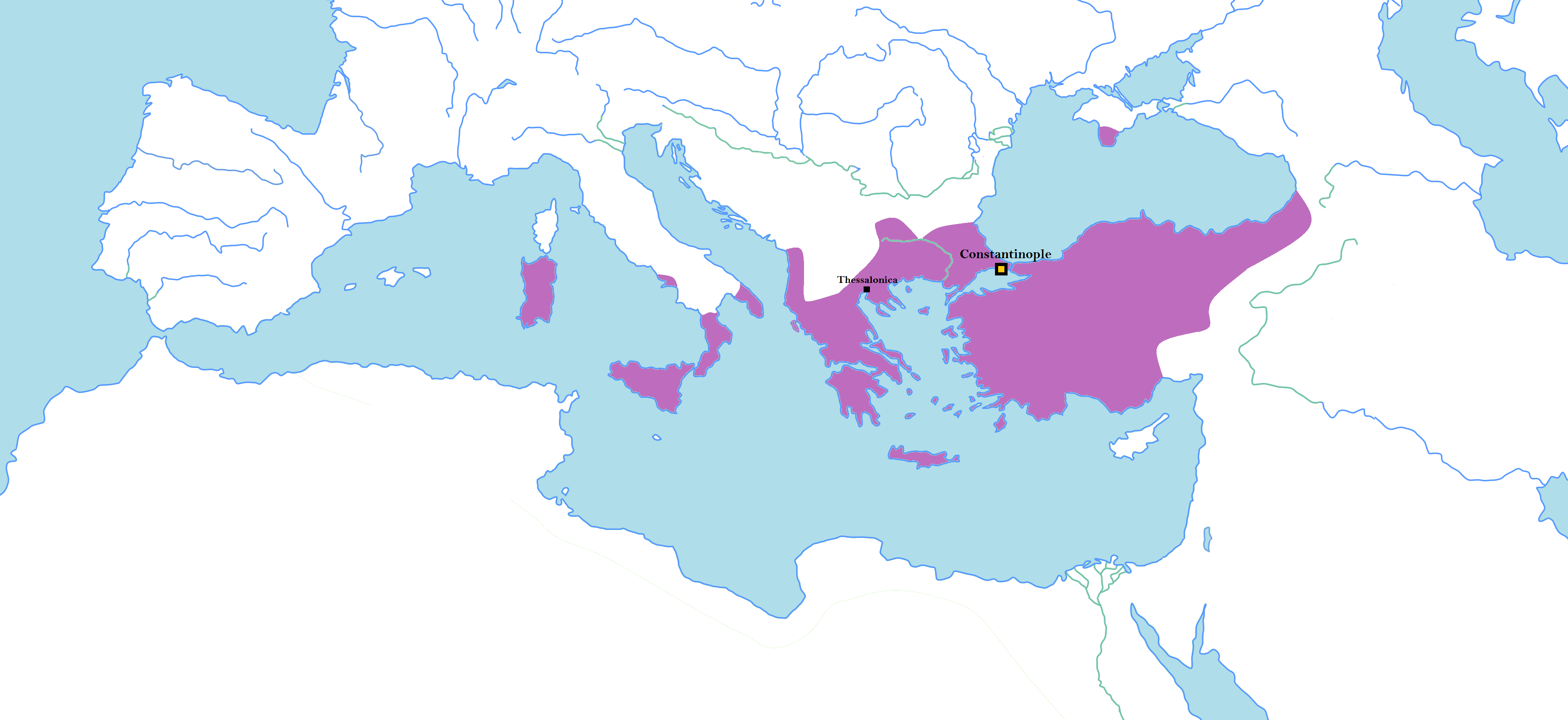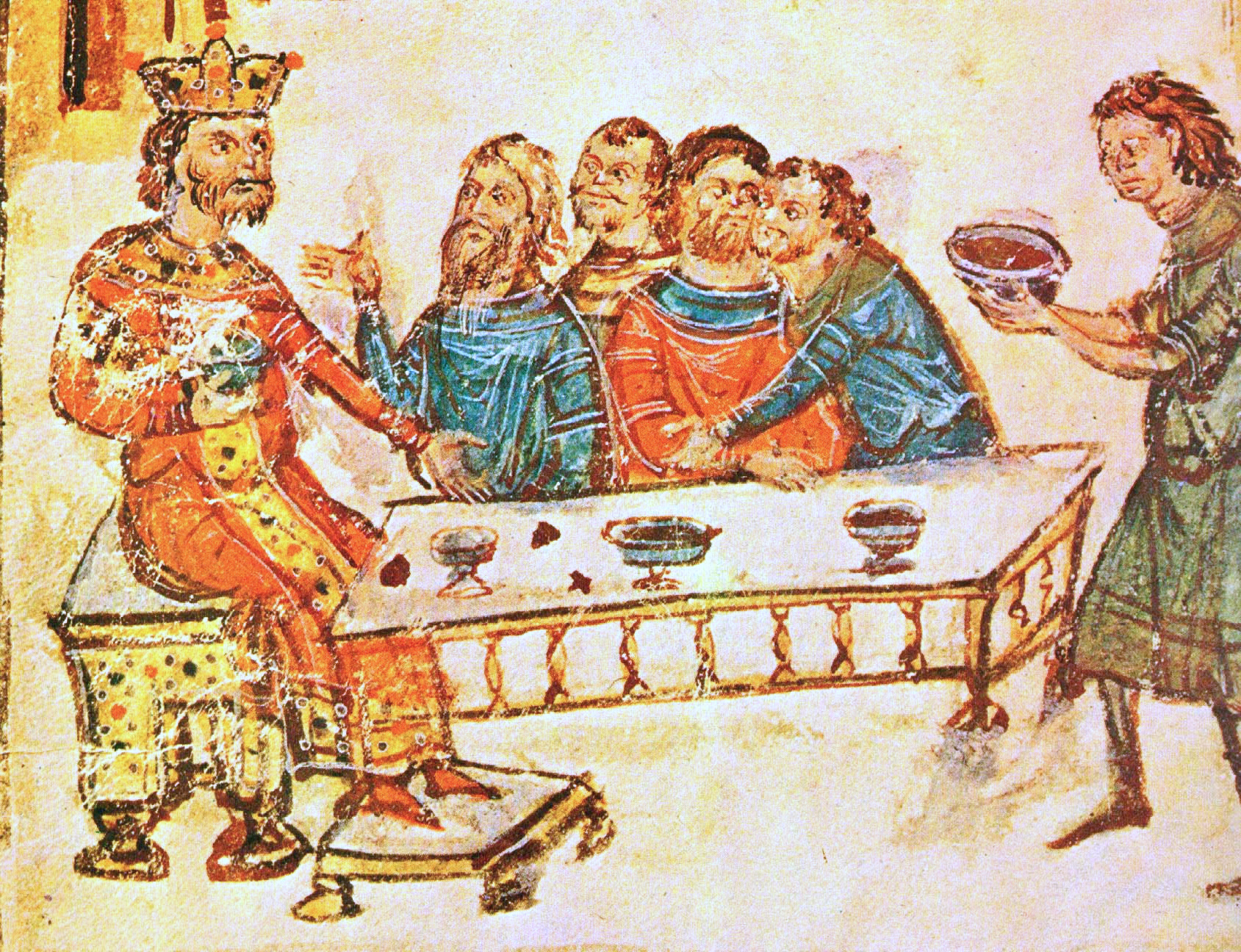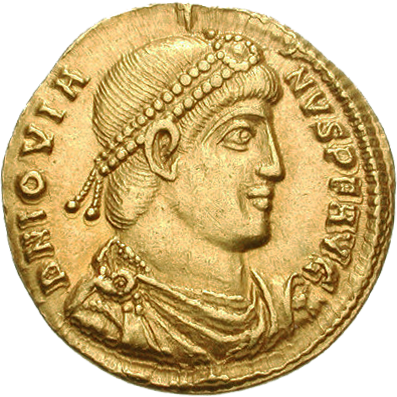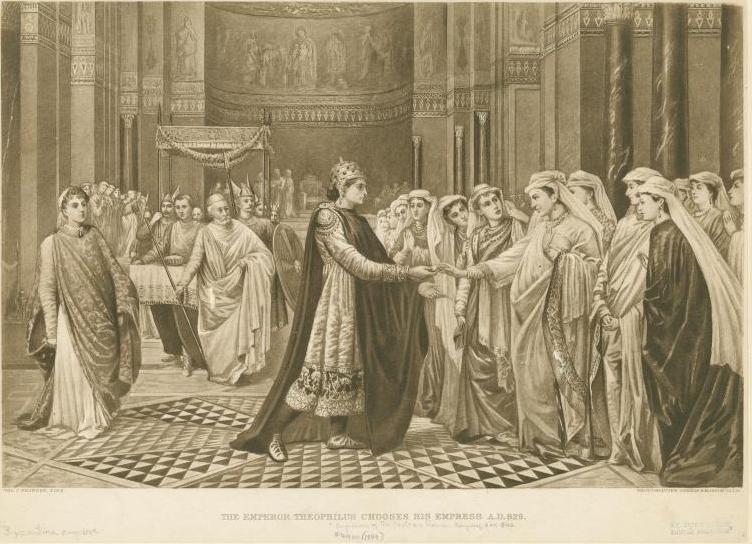|
Staurakios
Staurakios or Stauracius ( gr, Σταυράκιος, links=no; early 790s – 11 January 812AD) was Byzantine emperor from 26 July to 2 October 811. He was born in the early 790s, probably between 791 and 793, to Nikephoros I and an unknown woman. Nikephoros seized the throne of the Byzantine Empire from Empress Irene in 802, and elevated Staurakios to co-emperor on 25 December 803. On 20 December 807, a bride show was held by Nikephoros to select a wife for Staurakios, which resulted in his marriage to Theophano of Athens, a kinswoman of Irene. Little else is known of him until he came to take the throne upon the death of Nikephroros. Staurakios took part in an invasion of the Bulgarian Khanate in 811, alongside his father and brother-in-law. Although initially successful, with the Byzantines laying siege to the Bulgarian capital of Pliska and defeating a relief force, they were soon ambushed by Khan Krum, and trapped in a small valley. The Bulgarians then attacked, startin ... [...More Info...] [...Related Items...] OR: [Wikipedia] [Google] [Baidu] |
Aetios (eunuch)
Aetios or Aetius ( grc-gre, Ἀέτιος) was a Byzantine eunuch official and one of the most trusted advisers of Byzantine empress Irene of Athens (r. 797–802). After Irene's rise to sole rule, Aetios developed an intense rivalry with her eunuch chief minister Staurakios. After Staurakios's death, Aetios became the leading man in the state. He plotted to usurp the throne for his brother, Leo, but lost power when Irene was deposed in 802. Biography Early years and rivalry with Staurakios Aetios first appears in 790, when he was a ''protospatharios'' and a confidant of Irene, then the Byzantine empress-mother and regent for her young son, Emperor Constantine VI (r. 780–797). In the autumn of that year, Irene tried to sideline her son and assume full rule over the Byzantine Empire. This, however, caused a mutiny by the army in favour of the young emperor. Constantine was installed as sole ruler, Irene confined to a palace in Constantinople, and her eunuch protégés, including A ... [...More Info...] [...Related Items...] OR: [Wikipedia] [Google] [Baidu] |
Michael I Rangabe
Michael I Rhangabe ( gr, Μιχαὴλ Ῥαγγαβέ; ''c''. 770 – 11 January 844) was Byzantine emperor from 811 to 813. Michael was the son of the patrician Theophylact Rhangabe, the admiral of the Aegean fleet. He married Prokopia, the daughter of the former Emperor Nikephoros I, and received the high court dignity of ''kouropalatēs'' after his father-in-law's accession in 802. Life Michael survived Nikephoros' disastrous campaign against Krum of Bulgaria, and was considered a more appropriate candidate for the throne than his severely injured brother-in-law Staurakios. When Michael's wife Prokopia failed to persuade her brother to name Michael as his successor, a group of senior officials (the ''magistros'' Theoktistos, the Domestic of the Schools Stephen, and Patriarch Nikephoros) forced Staurakios to abdicate in his favor on 2 October 811. Michael I attempted to carry out a policy of reconciliation, abandoning the exacting taxation instituted by Nikephoros I. W ... [...More Info...] [...Related Items...] OR: [Wikipedia] [Google] [Baidu] |
Michael I Rhangabe
Michael I Rhangabe ( gr, Μιχαὴλ Ῥαγγαβέ; ''c''. 770 – 11 January 844) was Byzantine emperor from 811 to 813. Michael was the son of the patrician Theophylact Rhangabe, the admiral of the Aegean fleet. He married Prokopia, the daughter of the former Emperor Nikephoros I, and received the high court dignity of ''kouropalatēs'' after his father-in-law's accession in 802. Life Michael survived Nikephoros' disastrous campaign against Krum of Bulgaria, and was considered a more appropriate candidate for the throne than his severely injured brother-in-law Staurakios. When Michael's wife Prokopia failed to persuade her brother to name Michael as his successor, a group of senior officials (the ''magistros'' Theoktistos, the Domestic of the Schools Stephen, and Patriarch Nikephoros) forced Staurakios to abdicate in his favor on 2 October 811. Michael I attempted to carry out a policy of reconciliation, abandoning the exacting taxation instituted by Nikephoros I. ... [...More Info...] [...Related Items...] OR: [Wikipedia] [Google] [Baidu] |
Theophano Of Athens
Theophano ( gr, Θεοφανώ; died after 811) was the Empress consort of Staurakios of the Byzantine Empire. According to the chronicle of Theophanes the Confessor, Theophano was a relative of Irene (reigned 797–802). Both women were from Athens but the nature of their relation to each other is not known. On 20 December 807, Theophano married Staurakios. The date of their marriage was recorded by Theophanes. Staurakios was the only known son of Nikephoros I. He was co-emperor with his father since 803. Theophano had been betrothed to another man but took place in the imperial bride-show. She was possibly chosen to legitimise the connection of the new dynasty to their predecessor. Her father-in-law is presumed to have been a widower by the time he was elevated to the throne. In the absence of a senior empress, Theophano was the only Empress during his reign. On 26 July 811, Nikephoros was killed while fighting against Krum of Bulgaria at the Battle of Pliska. Much of the Byzant ... [...More Info...] [...Related Items...] OR: [Wikipedia] [Google] [Baidu] |
Prokopia
Prokopia (Greek: Προκοπία; c. 770 – after 813) was the Empress consort of Michael I Rhangabe of the Eastern Roman Empire. She was a daughter of Nikephoros I. The name of her mother is not known. Her only known sibling is Staurakios. Marriage Prokopia married Michael Rhangabe during the late 8th century. He was a son of Theophylaktos Rhangabe, admiral of the Aegean fleet. In 802, reigning Empress Irene was deposed by an alliance of patricians and eunuchs. Their leader was Nikephoros, father of Prokopia, who at the time held the position of finance minister ('' logothetēs tou genikou''). On 31 October 802, Nikephoros was declared to be the next Emperor, making Prokopia a member of the imperial family. Her husband received the high court dignity of ''kouropalatēs''. On 26 July 811, Nikephoros was killed while fighting against Krum of Bulgaria at the Battle of Pliska. Much of the Eastern Roman army was annihilated with him in what is considered one of the worst de ... [...More Info...] [...Related Items...] OR: [Wikipedia] [Google] [Baidu] |
Irene Of Athens
Irene of Athens ( el, Εἰρήνη, ; 750/756 – 9 August 803), surname Sarantapechaina (), was Byzantine empress consort to Emperor Leo IV from 775 to 780, regent during the childhood of their son Constantine VI from 780 until 790, co-ruler from 792 until 797, and finally empress regnant and sole ruler of the Eastern Roman Empire from 797 to 802. A member of the politically prominent Sarantapechos family, she was selected as Leo IV's bride for unknown reasons in 768. Even though her husband was an iconoclast, she harbored iconophile sympathies. During her rule as regent, she called the Second Council of Nicaea in 787, which condemned iconoclasm as heretical and brought an end to the first iconoclast period (730–787). Her public figure was very polarizing during her 5 year reign, as most saw a woman not right to solely rule. Her sole reign made her the first ever empress regnant, ruling in her own right, in Roman and Byzantine imperial history. She was influential in govern ... [...More Info...] [...Related Items...] OR: [Wikipedia] [Google] [Baidu] |
Nikephoros I
Nikephoros I or Nicephorus I ( gr, Νικηφόρος; 750 – 26 July 811) was Byzantine emperor from 802 to 811. Having served Empress Irene as '' genikos logothetēs'', he subsequently ousted her from power and took the throne himself. In reference to his career before becoming emperor, he is sometimes surnamed "the Logothete" (ὁ Λογοθέτης) and "Genikos" or "Genicus" (ὁ Γενικός). Nikephoros pursued wars against the Arabs and Bulgarians, with mixed results; while invading Bulgaria he was defeated and killed at the Battle of Pliska. Background Sources outside the Byzantine context, including Michael the Syrian, al-Tabari, and Mas'udi, preserve the tradition that Nikephoros was of Ghassanid Arab origin. al-Tabari claims that he derived this information from Byzantine sources, but no surviving Byzantine chronicle makes explicit mention of the emperor's ethnic background. The modern scholar Paul Julius Alexander suggests that al-Tabari did transmit informat ... [...More Info...] [...Related Items...] OR: [Wikipedia] [Google] [Baidu] |
Nikephorian Dynasty
Following the deposition of the Byzantine empress Irene of Athens, the throne of the Byzantine Empire passed to a relatively short-lived dynasty, the Nikephorian dynasty, named after its founder, Nikephoros I. The empire was in a weaker and more precarious position than it had been for a long time and its finances were problematic.Jenkins. Byzantium The Imperial Centuries AD 610-1071. p. 117 During this era Byzantium was almost continually at war on two frontiers which drained its resources, and like many of his predecessors, Nikephoros (802–811) himself died while campaigning against the Bulgars to the north. Furthermore, Byzantium's influence continued to wane in the west with the crowning of Charlemagne (800–814) as Holy Roman emperor by Pope Leo III at Old St. Peter's Basilica in Rome in the year 800 and the establishment of a new empire in Western Europe laying claim to the universal Roman monarchy. Nikephoros I, 802–811 Nikephoros I had been the empire's finance mi ... [...More Info...] [...Related Items...] OR: [Wikipedia] [Google] [Baidu] |
Krum
Krum ( bg, Крум, el, Κροῦμος/Kroumos), often referred to as Krum the Fearsome ( bg, Крум Страшни) was the Khan of Bulgaria from sometime between 796 and 803 until his death in 814. During his reign the Bulgarian territory doubled in size, spreading from the middle Danube to the Dnieper and from Odrin to the Tatra Mountains. His able and energetic rule brought law and order to Bulgaria and developed the rudiments of state organization. Biography Origins Krum was a Bulgar chieftain from Pannonia. His family background and the surroundings of his accession are unknown. It has been speculated that Krum might have been a descendant of the old Bulgar royal house of Kubrat. The name Krum is of Turkic origin and means "governor prince" (from ''kurum'' "rule, leadership, administration"). Establishment of new borders Around 805, Krum defeated the Avar Khaganate to destroy the remainder of the Avars and to restore Bulgar authority in Ongal again, the tradition ... [...More Info...] [...Related Items...] OR: [Wikipedia] [Google] [Baidu] |
List Of Byzantine Emperors
This is a list of the Byzantine emperors from the foundation of Constantinople in 330 AD, which marks the conventional start of the Eastern Roman Empire, to its fall to the Ottoman Empire in 1453 AD. Only the emperors who were recognized as legitimate rulers and exercised sovereign authority are included, to the exclusion of junior co-emperors (''symbasileis'') who never attained the status of sole or senior ruler, as well as of the various usurpers or rebels who claimed the imperial title. The following list starts with Constantine the Great, the first Christian emperor, who rebuilt the city of Byzantium as an imperial capital, Constantinople, and who was regarded by the later emperors as the model ruler. It was under Constantine that the major characteristics of what is considered the Byzantine state emerged: a Roman polity centered at Constantinople and culturally dominated by the Greek East, with Christianity as the state religion. The Byzantine Empire was the direct lega ... [...More Info...] [...Related Items...] OR: [Wikipedia] [Google] [Baidu] |
Byzantine Emperor
This is a list of the Byzantine emperors from the foundation of Constantinople in 330 AD, which marks the conventional start of the Eastern Roman Empire, to its fall to the Ottoman Empire in 1453 AD. Only the emperors who were recognized as legitimate rulers and exercised sovereign authority are included, to the exclusion of junior co-emperors (''symbasileis'') who never attained the status of sole or senior ruler, as well as of the various usurpers or rebels who claimed the imperial title. The following list starts with Constantine the Great, the first Christian emperor, who rebuilt the city of Byzantium as an imperial capital, Constantinople, and who was regarded by the later emperors as the model ruler. It was under Constantine that the major characteristics of what is considered the Byzantine state emerged: a Roman polity centered at Constantinople and culturally dominated by the Greek East, with Christianity as the state religion. The Byzantine Empire was the direct le ... [...More Info...] [...Related Items...] OR: [Wikipedia] [Google] [Baidu] |
Bride-show
The bride-show ( el, δείχνουν οι νύμφες, russian: смотр невест) was a custom of Byzantine emperors and Russian tsars to choose a wife from among the most beautiful maidens of the country. A similar practice also existed in Imperial China. See also *Beauty pageant *Book of Esther The Book of Esther ( he, מְגִלַּת אֶסְתֵּר, Megillat Esther), also known in Hebrew language, Hebrew as "the Scroll" ("the wikt:מגילה, Megillah"), is a book in the third section (, "Writings") of the Judaism, Jewish ''Tanak ... References Further reading {{commons category, The Bride-show *Afinogenov, D. "The Bride-show of Theophilos: Some notes on the Sources", ''Eranos'' 95. 1997, pp. 10–18. *Rydén, Lennart. "The Bride-shows at the Byzantine Court - History or Fiction?" ''Eranos'' 83, 1985, pp. 175–191. *Treadgold, W. T., "The Bride-shows of the Byzantine Emperors", ''Byzantion'' 49. 1979, pp. 395–413. * Bourboulis, Photeine ... [...More Info...] [...Related Items...] OR: [Wikipedia] [Google] [Baidu] |
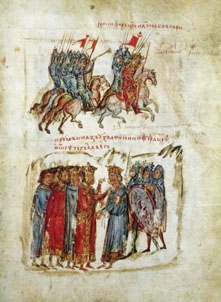
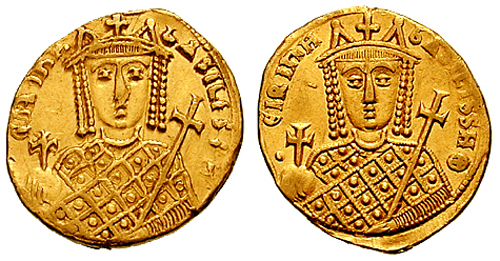
.jpg)
